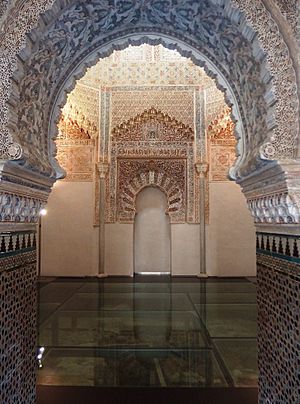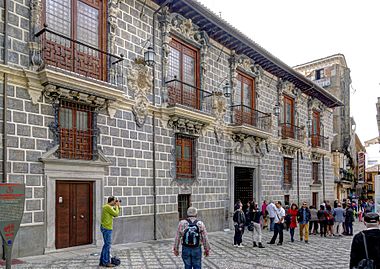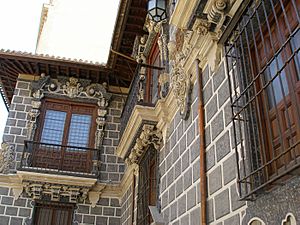Madrasa of Granada facts for kids
The Madrasa of Granada (which means "school" or "university" in Arabic) is a very old building in Granada, Spain. It's also known as the Palacio de la Madraza. It was built in 1349 by Yusuf I, who was the ruler (called a Sultan or Emir) of Granada at that time.
This special building was once a famous Islamic school. Today, it is part of the University of Granada. It is also home to the Royal Academy of Fine Arts. The Madrasa is right in the middle of the city. It's close to where the main mosque used to be, which is now the Granada Cathedral. It was also near a busy market where valuable things like silk and gold were sold.
Contents
History of the Madrasa

Building a Great School
The Madrasa was built in 1349 CE by Yusuf I. He was the ruler of Granada from the Nasrid dynasty. Madrasas were new types of schools in this area. They first appeared in Iran in the 11th century and then spread west. Many were built in Morocco around this time. The Madrasa of Yusuf I is the only big one known to have been built in al-Andalus (what southern Spain was called then).
Rulers built these schools to train smart people. These people could then work for the government. It also helped attract important teachers. Building a madrasa made the rulers look good and show they were good Muslims. The main subjects taught were Islamic law and Arabic grammar. Other subjects were also taught. Famous scholars like Ibn Marzuq taught here. Ibn al-Khatib was also a student.
Changes After the Conquest
After the Granada War in 1492, the Spanish took over Granada. The Madrasa kept running until about 1500. This was part of an agreement called the Treaty of Granada (1491). In this treaty, the Muslim ruler Boabdil gave up Granada to the Christian rulers, Ferdinand and Isabella.
However, things changed. In 1499, there was an uprising by Muslims. Because of this, the agreement was cancelled. A man named Gonzalo Jimenez de Cisneros took action. He ordered that the books from the Madrasa's library be taken to a public square. There, they were sadly burned in a huge bonfire.
After this, the building was closed. In 1500, it became the new city hall, called the Casa del Cabildo. Most of the original madrasa building was torn down between 1722 and 1729. A new, fancy building in the Baroque style was built in its place. This new building was designed by José de Bada.
In 1858, the city hall moved. The building was sold and used as a place to store cloth. A few years later, a special inscription from the old prayer room was found. The building also had some fire damage. Rafael Contreras, who also restored the Alhambra, helped fix it.
The city bought the building back in the early 1900s. More restoration work was done in 1939. In 1976, the building became part of the University of Granada. It has been restored many times since then. Big archaeological digs happened in 2006–2007. The building was opened to visitors in 2011.
What Was Taught at the Madrasa
The Madrasa taught many different subjects. These included:
- Theology (the study of religion)
- Law
- Medicine
- Astronomy (the study of stars and planets)
- Logic (how to think clearly)
- Mathematics, including geometry
- Mechanics (how things work)
A scholar named Ibn Hazm once wrote about the education in al-Andalus. He said students should first study mathematics. Then, they should learn about the stars and planets. They should also study how things work in nature.
Architecture of the Building
The Original Madrasa Building
The original Madrasa built by Yusuf I was very beautiful. Its outside walls were covered in white marble. Some pieces of this marble still exist today. They are kept in the Archaeological Museum of Granada. The main entrance probably had a horseshoe-shaped arch. This arch was framed by a special border called an alfiz.
The outside of the building had poems and wise sayings carved into it. One saying was: "If you want to learn and escape ignorance, you will find the beautiful tree of honor here. Let study shine like stars for everyone."
Inside, the building was built around a pool in the center. Most madrasas had this design. Student rooms were usually around this central courtyard. On one side of the courtyard was a prayer room. This prayer room is the only part of the original building that is still standing and has been restored.
The prayer room is square, about 6.84 meters (22 feet) on each side. It has a high ceiling. About halfway up the walls, the room changes from a square to an eight-sided shape. This change is made with special carved decorations called muqarnas in the corners. The rest of the walls are covered in beautiful stucco decorations. These designs include fancy patterns and Arabic writing. There are also 16 windows high up on the walls. The ceiling is made of wood and has more muqarnas carvings.
Later Changes to the Palace
After the Christian conquest, a house next door was added to make the building bigger. A special eight-sided room called the Sala de Cabildos was built. It has a unique style called Mudéjar, which mixes Christian and Islamic art. This room was decorated in 1513. It included a message about the Christian capture of the city.
Later, the central pool was filled in and used for other things. The building changed a lot, especially between 1722 and 1729. This was when the Baroque style was popular. So, the building we see today is mostly from the 18th century. But it still has parts of the older buildings.
The prayer room (or mihrab) is original from the 14th century. The Sala de los Caballeros XXIV, which was a council room, has a wonderful wooden ceiling called an artesonado. The outside of the building, with its rich carvings around the windows and entrance, is in a very decorative Baroque style called Churrigueresque.
Discoveries from Archeology
During the archaeological digs in 2006–2007, many old things were found. They found signs of even older buildings on the site, some from as far back as the 11th century. They also found two human burials under what is now the prayer room. These burials are very old, possibly from Roman times, but most likely from after the Muslim conquest of Spain.
See also
 In Spanish: Madraza de Granada para niños
In Spanish: Madraza de Granada para niños





